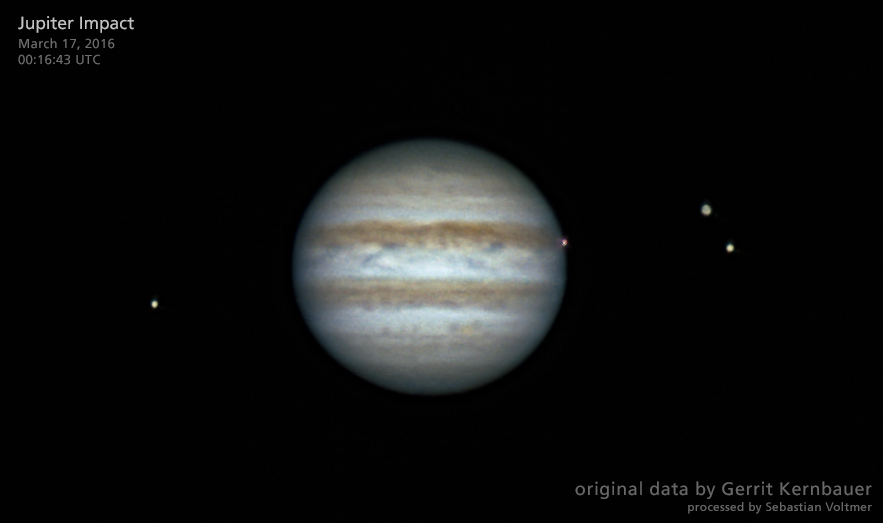
A new view of the March 17, 2016, asteroid- or comet-strike that lit up Jupiter’s right-hand limb.
Credit: Sebastian Voltmer and Gerrit Kernbauer
A stunning photo provides a dramatic new look at the cosmic impact that walloped Jupiter last month.
The image, a still from a video by amateur astronomer Gerrit Kernbauer, shows a bright flash of light on the right-hand side of Jupiter , and also captures three of the gas giant’s many moons in the scene. The photo, which was processed by Kernbaur’s colleague Sebastian Voltmer of Germany, enhances the color and detail of a frame of video that Gerrit Kernbauer took of the March 17 impact from Mödling, Austria.
Jupiter is the largest planet in the solar system and therefore has the most powerful gravitational pull of all the planets. That means a lot of asteroids and comets slam into the gas giant’s thick atmosphere, and some of these collisions are visible from Earth. [Comet Shoemaker-Levy 9’s Epic Jupiter Crash in Pictures ]
The most famous such incident was the impact of Comet Shoemaker-Levy 9, which scarred Jovian skies for months back in 1994. Amateur astronomers also recorded Jupiter impacts in 2009, 2010 (twice) and 2012, in addition to the St. Patrick’s Day event this year.
“The seeing was not the best, so I hesitated to process the videos,” Kernbauer wrote about his video, which he posted to YouTube on March 26. (The video has racked up more than 4 million views since then.)
“Nevertheless, 10 days later, I looked through the videos, and I found this strange light spot that appeared for less than 1 second on the edge of the planetary disc,” Kernbauer added. “Thinking back to Shoemaker-Levy 9, my only explanation for this is an asteroid or comet that enters Jupiter’s high atmosphere and burned up/exploded very fast.”Kernbauer is one of two known amateurs who recorded the March 17 impact. Another video of the collision was posted by John McKeon, who was viewing Jupiter from Swords, Ireland, with an 11-inch Schmidt-Cassegrain telescope. (McKeon was originally recording the transit of the Jovian moons Io and Ganymede across the planet’s face.)
In an interview with Space.com in March, NASA asteroid expert Paul Chodas said the increasing number of observations like those made by Kernbauer and McKeon shows just how much amateur equipment has improved in recent years — as well as the dedication of stargazers.
“Better and better instruments mean Jupiter is being monitored, even by amateur astronomers, much more than it was in the past,” Chodas said.
Jupiter will also get a spacecraft visitor later this year. NASA’s Juno orbiter is scheduled to arrive at the planet on July 4 to study the gas giant’s magnetic field, composition and structure, among other things.
Follow Elizabeth Howell @howellspace , or Space.com @Spacedotcom . We’re also on Facebook and Google+ . Original article on Space.com .
Comments are closed.